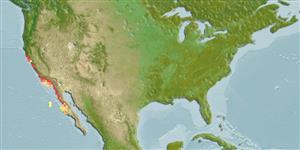>
Blenniiformes (Blennies) >
Chaenopsidae (Pike-, tube- and flagblennies)
Etymology: Neoclinus: Greek,neos = new + Greek, klinein, kline = sloping and bed, due to the four apophyses of sphenoid bone (Ref. 45335); uninotatus: Neoclinus new Clinus ; uninotatus one mark, for the single ocellatus (Ref. 4930).
Environment: milieu / climate zone / depth range / distribution range
Ekologi
laut dasar (demersal); kisaran kedalaman 3 - 27 m (Ref. 2850). Subtropical; 39°N - 27°N, 124°W - 114°W
Eastern Pacific: Bodega Bay in northern California, USA to northern Baja California, Mexico.
Length at first maturity / Size / Weight / umur
Maturity: Lm 8.9 range ? - ? cm
Max length : 25.0 cm TL jantan/; (Ref. 2850); Umur maksimum dilaporkan: 7 Tahun (Ref. 43439)
Usually occurs on bottom along coast and in bays. Lives inside objects, including bottles, cans, and tires.
Females lay eggs in abandoned boring clam holes, under rocks, in beer containers, and other containers. Males guard the eggs until they hatch (Ref. 43439).
Eschmeyer, W.N., E.S. Herald and H. Hammann, 1983. A field guide to Pacific coast fishes of North America. Boston (MA, USA): Houghton Mifflin Company. xii+336 p. (Ref. 2850)
Status IUCN Red List (Ref. 130435: Version 2024-1)
ancaman kepada manusia
Harmless
penggunaan manusia
Alat, peralatan
laporan khas
muat turun XML
Sumber internet
Estimates based on models
Preferred temperature (Ref.
123201): 12.8 - 19, mean 15.9 °C (based on 43 cells).
Phylogenetic diversity index (Ref.
82804): PD
50 = 0.5005 [Uniqueness, from 0.5 = low to 2.0 = high].
Bayesian length-weight: a=0.00525 (0.00219 - 0.01260), b=3.06 (2.85 - 3.27), in cm total length, based on LWR estimates for this (Sub)family-body shape (Ref.
93245).
Trophic level (Ref.
69278): 3.5 ±0.50 se; based on food items.
Daya lenting (Ref.
120179): sedang, Waktu penggandaan populasi minimum 1.4 - 4.4 tahun (tm=1; tmax=7; Fec = 600).
Fishing Vulnerability (Ref.
59153): Low vulnerability (15 of 100).
